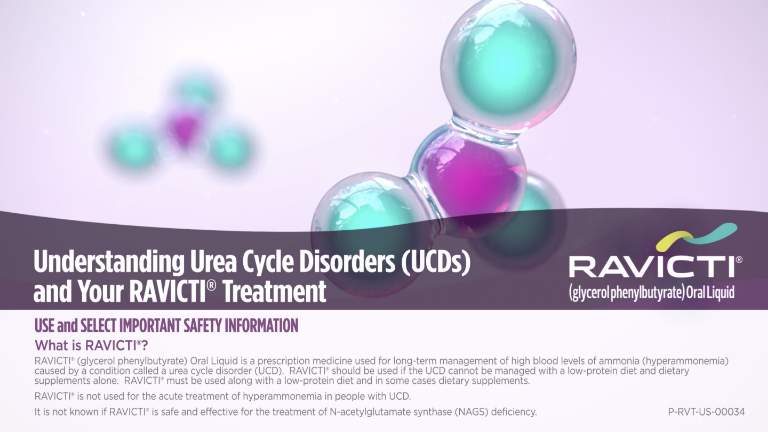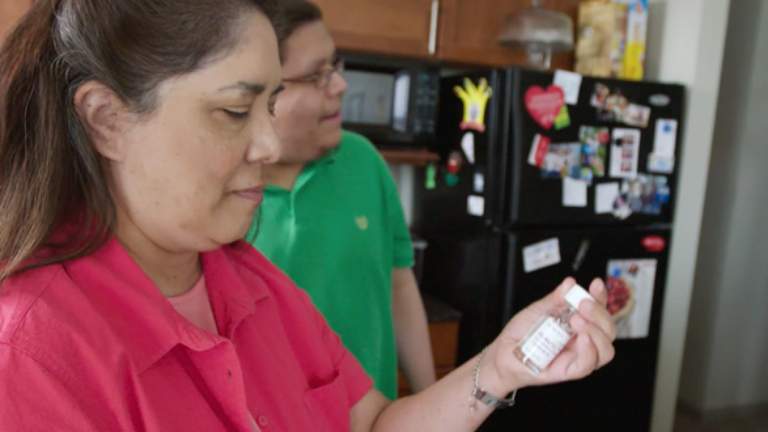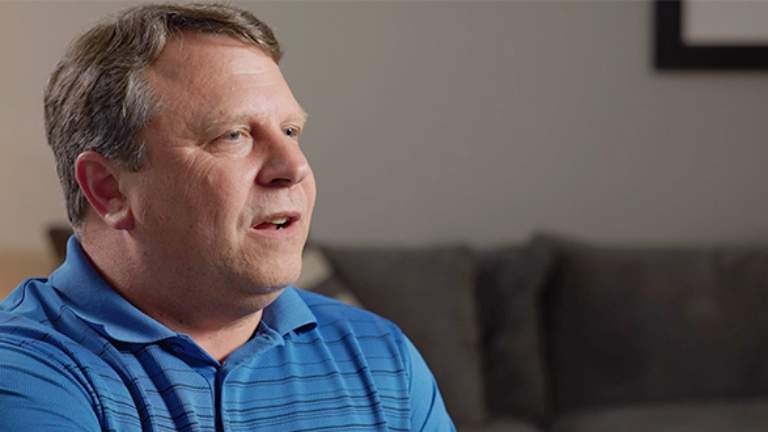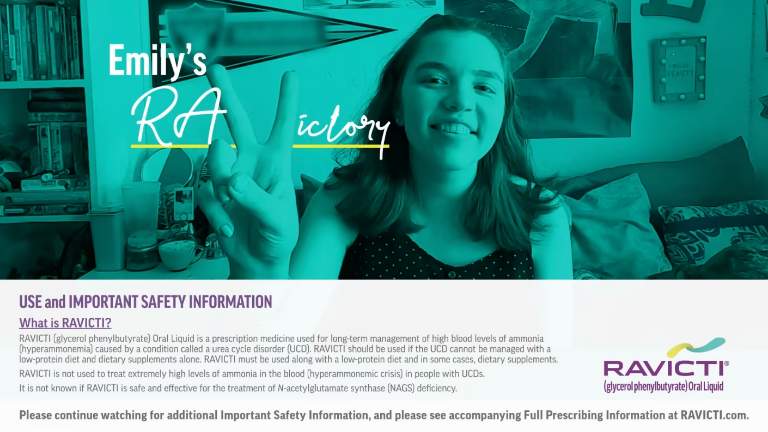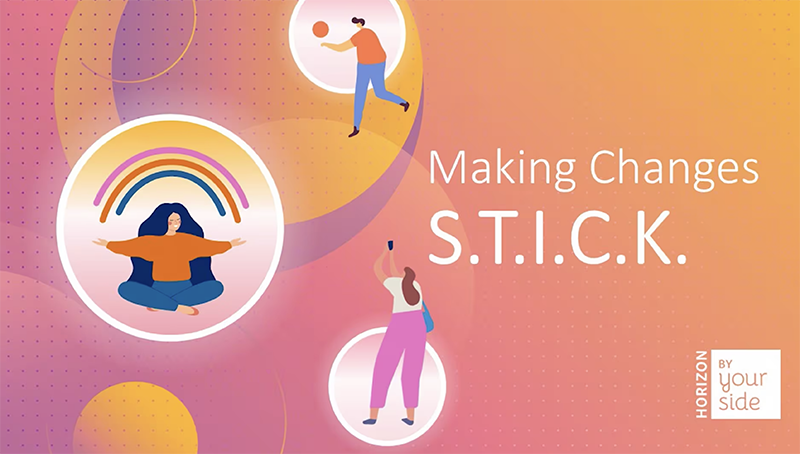Welcome to the RAVICTI (glycerol phenylbutyrate) Oral Liquid instructional dosing video.
In this video, you will see step-by-step instructions for administration of RAVICTI if you or your child have a nasogastric or gastrostomy feeding tube.
If you can swallow liquids, it is recommended you take RAVICTI by mouth.
This video is intended to complement the instructions you have already received from your doctor. Always take RAVICTI exactly as directed by your doctor.
Do not mix RAVICTI with formula or any other liquids.
Now, let’s get started.
Your RAVICTI shipment includes:
a 25-milliliter bottle of RAVICTI, a reclosable bottle cap adapter, and an oral syringe.
When dosing RAVICTI, be sure to use a new dry oral syringe.
First, remove the childproof cap on the RAVICTI bottle. To do that, push down on the cap while twisting it to the left.
Then, attach the reclosable bottle cap adapter onto the bottle. Put it on top of the bottle and twist it to the right.
Make sure it is secured tightly on the bottle.
While holding the RAVICTI bottle securely, place the tip of the oral syringe into the reclosable bottle cap adapter.
Turn the bottle upside down with the oral syringe still inserted.
Now you’re ready to fill the oral syringe with RAVICTI.
Withdraw the prescribed dose of RAVICTI with the dry oral syringe by pulling the plunger back.
Pull the plunger back until the first line of the black rubber stopper is even with the dosing mark. The dosing marks are on the barrel of the oral dosing syringe. Match the dosing mark with the amount of medicine prescribed by your doctor.
Then, turn the bottle upright again.
If there are large air bubbles, push the medicine back into the bottle. Do this slowly.
Then draw up the medicine again.
Next, place the tip of the oral syringe into the smaller port of the feeding tube.
The smaller port of the nasogastric or gastrostomy feeding tube is used for medicine.
Ask your doctor if you are not sure which port to use.
Using the plunger of the oral dosing syringe, slowly and carefully push RAVICTI into the feeding tube.
Make sure all of the medicine is pushed out of the oral dosing syringe.
After you have pushed all of the RAVICTI into the feeding tube, remove the oral syringe, put the cap on the oral syringe, and set it aside.
Close the tab on the reclosable bottle cap adapter.
Make sure it’s closed tightly.
Use a separate large syringe to flush water into the feeding tube. A large syringe can be found in the box containing your feeding tube.
Make sure all of the water or formula drains through the feeding tube.
For patients who have a nasogastric tube or gastrostomy tube in place, give RAVICTI as follows:
- Use an oral syringe to withdraw the prescribed dosage of RAVICTI from the bottle.
- Place the tip of the syringe into the tip of the gastrostomy/nasogastric tube.
- Using the plunger of the syringe, push RAVICTI into the tube.
- Flush once with 10 mL of water or formula and allow the flush to drain.
- If needed, flush a second time with an additional 10 mL of water or formula to clear the tube.
You can use 1 oral syringe and 1 reclosable bottle cap adapter for all doses each day.
You can also choose to use a new oral syringe with each dose.
Do not rinse the reclosable bottle cap adapter or oral syringe between doses.
After the last dose of the day, dispose of the oral syringe.
Take the exact amount of RAVICTI Oral Liquid as instructed by your doctor.
Your doctor may change your dose if needed.
Take RAVICTI with food or formula.
In an infant who is breastfeeding, give RAVICTI just prior to breastfeeding.
Use a new reclosable bottle cap adapter with each new bottle of RAVICTI that is opened.
Use a new dry oral syringe to withdraw each prescribed dose of RAVICTI.
If you take too much RAVICTI, call your doctor or the Poison Control Center at 1-800-222-1222 or go to the nearest hospital emergency room right away.
Do not stop taking RAVICTI unless your doctor tells you to stop.
If you miss a dose of RAVICTI, take it as soon as possible.
Do not take 2 doses of RAVICTI at the same time.
If you miss more than 1 dose and are not feeling well, call your doctor or nurse right away.
If you still have questions about how to take RAVICTI with an oral syringe, please contact your doctor for more information.
1. For patients who require a volume of less than 1 mL per dose via nasogastric or gastrostomy tube, the delivered dosage may be less than anticipated due to adherence of RAVICTI to the plastic tubing. Therefore, these patients should be closely monitored using ammonia levels following initiation of RAVICTI dosing or dosage adjustments.
If RAVICTI is in contact with water, it will become cloudy in appearance.
If the contents are in contact with water or cloudy, then do not use the remaining RAVICTI and contact your prescribing doctor or pharmacy.
Discard bottle and any remaining contents 28 days after opening.
Ask your pharmacist for oral syringes and a reclosable bottle cap adapter for each bottle you receive if you do not have them.
USE and IMPORTANT SAFETY INFORMATION
What is the most important information I should know about RAVICTI?
RAVICTI may cause serious side effects, including: Nervous system side effects (Neurotoxicity) Phenylacetate (PAA), a breakdown product of RAVICTI, may cause nervous system side effects. Call your doctor or get medical help right away if you have any of these symptoms while taking RAVICTI:
- sleepiness
- lightheadedness
- change in taste
- problems with hearing
- confusion
- problems with memory
- worsening of numbness, tingling, or burning in your hands or feet
- headache
- feeling very tired (fatigue)
- nausea
- vomiting
Your doctor may do blood tests to measure the amount of PAA in your blood during your treatment with RAVICTI.
What is RAVICTI?
- RAVICTI (glycerol phenylbutyrate) Oral Liquid is a prescription medicine used for long-term management of high blood levels of ammonia (hyperammonemia) caused by a condition called a urea cycle disorder (UCD). RAVICTI should be used if the UCD cannot be managed with a low-protein diet and dietary supplements alone. RAVICTI must be used along with a low-protein diet and in some cases dietary supplements.
- RAVICTI is not used for the acute treatment of hyperammonemia in people with UCD.
- It is not known if RAVICTI is safe and effective for the treatment of N-acetylglutamate synthase (NAGS) deficiency.
Do not take RAVICTI if you are allergic to phenylbutyrate. Call your doctor or go to the nearest hospital emergency room if you have wheezing, shortness of breath, cough, low blood pressure, flushing, nausea or a rash while taking RAVICTI.
Before taking RAVICTI, tell your doctor about all of your medical conditions, including if you:
- have liver or kidney problems.
- have pancreas or bowel (intestine) problems.
- are pregnant or plan to become pregnant. It is not known if RAVICTI will harm your unborn baby. If you become pregnant during treatment with RAVICTI, call Horizon at 1‐866‐479‐6742 to report the pregnancy.
- are breastfeeding or plan to breastfeed. It is not known if RAVICTI passes into your breast milk. Breastfeeding is not recommended during treatment with RAVICTI. Talk to your doctor about the best way to feed your baby if you take RAVICTI.
What are possible side effects of RAVICTI?
RAVICTI may cause serious side effects, including:
- See “What is the most important information I should know about RAVICTI?”
The most common side effects of RAVICTI in adults include:
- diarrhea
- gas
- headache
- abdomen (stomach) pain
- vomiting
- tiredness
- decreased appetite
- indigestion or heartburn
The most common side effects of RAVICTI in children 2 years to 17 years of age include:
- upper abdomen (stomach) pain
- rash
- nausea
- vomiting
- diarrhea
- decreased appetite
- headache
The most common side effects of RAVICTI in children 2 months to less than 2 years of age include:
- low white blood cell count (neutropenia)
- vomiting
- constipation
- diarrhea
- fever
- reduced food intake
- cough
- stuffy nose
- runny nose
- skin rash
- small round bumps on the skin
The most common side effects of RAVICTI in children less than 2 months of age include:
- vomiting
- rash
- gastroesophageal reflux
- increased levels of liver enzymes in the blood
- decreased appetite and reduced food intake
- low red blood cell count (anemia)
- cough
- loss of too much body fluid (dehydration)
- too much acid in the blood (acidosis)
- high blood platelet count (thrombocytosis)
- low blood platelet count (thrombocytopenia)
- low blood neutrophil count (type of white blood cell) (neutropenia)
- high white blood cell count (lymphocytosis)
- diarrhea
- gas
- constipation
- fever
- drowsiness (lethargy)
- irritability
- agitation
These are not all of the possible side effects of RAVICTI. Call your doctor for medical advice about side effects. You may report side effects to FDA at 1-800-FDA-1088.
For additional Important Safety Information, please review the Medication Guide at RAVICTI.com and discuss with your doctor.



